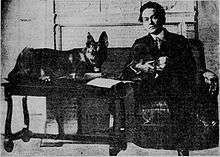Royal Dixon
Royal Dixon (25 March 1885? – 4 June 1962[1]) was an American author, animal rights activist and a member of the Americanization movement. He was, along with Diana Belais (1858–1944), a founder of the "First Church for Animal Rights" in 1921.

Biography
Dixon was born at Huntsville, Texas, to Elijah and Francis Elizabeth Dixon. and educated at the Sam Houston Normal Institute, Morgan Park Academy, Chicago and later as a special student at the University of Chicago. His earliest career was as a child actor and dancer trained by Adele Fox. His last theatre appearance was in 1903 as an actor with the Iroquois theater in Chicago.[2] He became a curator at the department of botany at the Field Museum of Chicago from 1905 to 1910. He subsequently became a staff writer at the Houston Chronicle. He also made special contributions to the newspapers of New York, where he lectured for the Board of Education and founded a school for creative writing. His interest and attention were later directed to immigration, as a director of publicity of the Commission of Immigrants in America, and as managing editor of The Immigrants in America Review. He published a book on how immigrants needed to be "americanized" into a single uniform culture.[3]
The First Church of Animal Rights
In 1921, Dixon founded, along with Diana Belais, Dr. S.A. Schneidmann and several others, the First Church for Animal Rights in Manhattan and it had a membership of about 300 people. The inauguration of the church was held on 13 March 1921 at the Hotel Astor. Nearly 400 people attended the inauguration and the speakers included Mrs Edwin Markham, Dr John Edward Oster, Mrs Margaret Crumpacker, Miss Jessie B. Rittenhouse, Dr. A.L. Lucas and Miles M. Dawson. A full list of the church's objectives included:[4][2]
- To preach and teach the oneness of all life, and awaken the humane consciousness
- To champion the cause of animals' rights
- To develop the character of youth through humane education
- To train and send forth humane workers
- To awaken the realization that every living creature has the inalienable right to life, liberty and the pursuit of happiness
- To act as a spiritual fountain-head and spokesman of human organizations and animal societies, and give a better understanding of their work and needs to the public.
Personal life
Dixon lived with his partner, a local artist, Chester Snowden. Dixon's letters and works are archived at the University of Houston Library.[5] Dixon was buried in Houston's Glenwood Cemetery[6]
Publications
His published works include:
- The Human Side of Plants (1914)
- Signs is Signs (1915)
- Americanization (1916)
- Forest Friends (1916)
- The Human Side of Trees : wonders of the world (1917)
- The Human Side of Birds (1917)
- The Human Side of Animals (1918)
- Hidden Children (1922)
- (With Franklyn E. Fitch) Personality of Plants (1923)
- (With Brayton Eddy) Personality of Insects (1924)
- The Ape of Heaven (1936)
- Half Dark Moon (1939)
References
- These are the dates given in New International Encyclopedia but an alternative 1876-1963 is suggested in Clifton, Merritt (2016). The 1st Church of Animal Rights tried to launch the movement in 1921 Animals 24-7.
- "Founder of the Animal Church explains all about it" (PDF). New York Tribune. 27 March 1921. p. 5.
- Williamson, C.C. (1919). "[Review] Americanization by Royal Dixon". National Municipal Review. 8 (1): 72–73. doi:10.1002/ncr.4110080118.
- Mighetto, Lisa (1988). "Wildlife Protection and the New Humanitarianism". Environmental Review. 12 (1): 37–49. JSTOR 3984376.
- Barnes, Elizabeth. "Royal Dixon Manuscripts, 1914-1962". University of Houston Libraries. Retrieved 12 February 2016.
- Royal Dixon and Chester Snowden by Brandon Wolf.
External links
- Royal Dixon Papers Now Available (2016)
- Works by Royal Dixon at Project Gutenberg
- Works by or about Royal Dixon at Internet Archive
- Works by Royal Dixon at LibriVox (public domain audiobooks)
